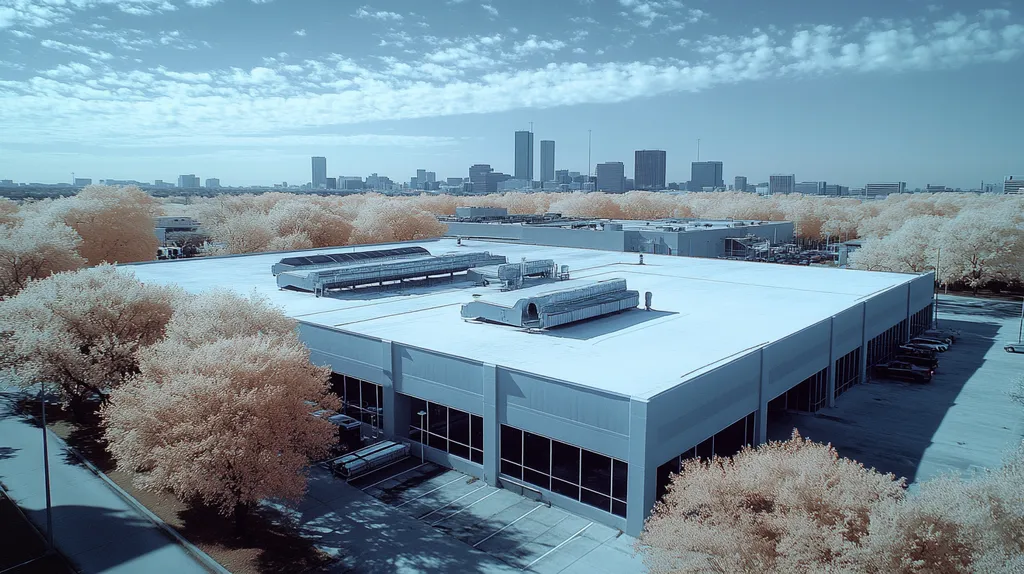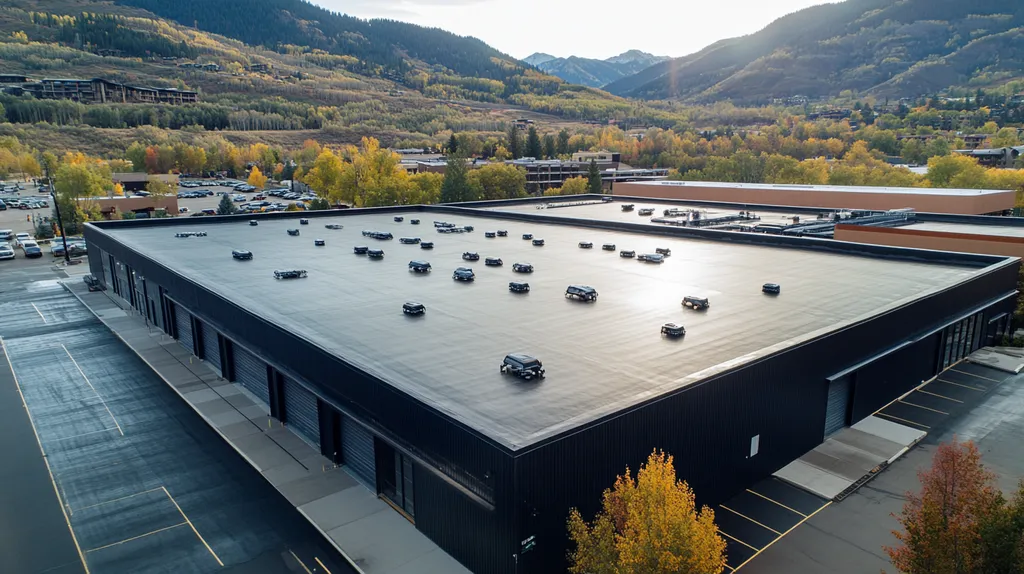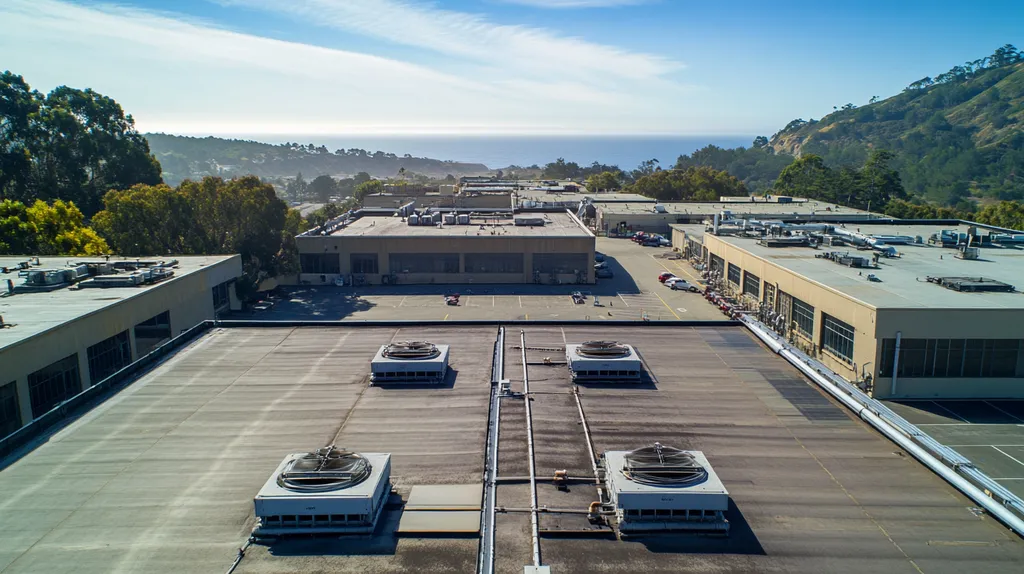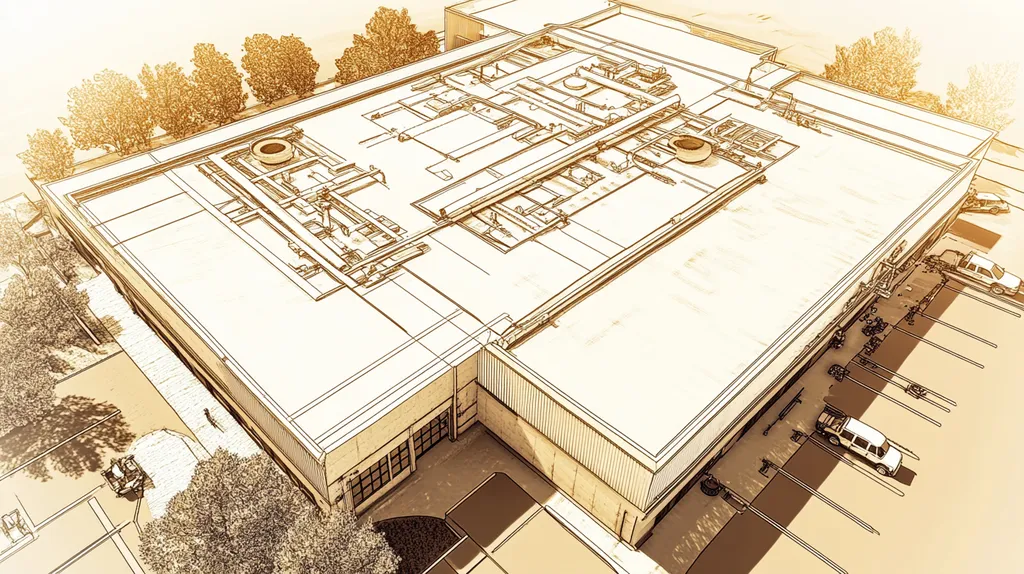Commercial roofs are failing at an alarming rate as extreme weather events intensify, with storm-related damages now exceeding $3 billion annually across North America.
Traditional roofing approaches, developed during periods of milder weather patterns, increasingly prove inadequate against today’s severe climate challenges.
This analysis examines why conventional roof protection methods fall short, revealing systemic vulnerabilities in current practices while highlighting emerging solutions that could revolutionize weather resilience in commercial roofing.
SECTION 1: CURRENT PRACTICES
The commercial roofing industry faces unprecedented challenges as weather patterns become increasingly extreme and unpredictable. Windstorms alone have caused over $1 trillion in economic damages over the past four decades, with insured hurricane losses now 11% higher due to climate change impacts. Traditional approaches to roof protection are proving inadequate against these intensifying threats, exposing businesses to significant financial and operational risks. (source: FEMA National Preparedness Report)
Overreliance on Legacy Materials and Methods
Commercial roofing continues to depend heavily on traditional materials and installation techniques that were developed during periods of milder weather patterns. These legacy systems often lack the resilience needed to withstand today’s more severe climate conditions.
Standard built-up roofing (BUR) and traditional single-ply membranes remain popular despite their limitations in extreme conditions. These systems frequently fail to account for increased wind loads and temperature fluctuations that characterize modern weather events.
Cost considerations often drive decision-makers to choose familiar but outdated solutions. While these materials may offer lower initial expenses, they typically result in higher lifetime costs due to frequent repairs and premature replacement needs.
Many current installation methods also fail to account for regional climate variations, leading to standardized approaches that may prove inadequate in areas facing specific weather challenges.
Inadequate Weather Resistance Testing Protocols
Current testing standards for commercial roofing materials often fail to reflect real-world conditions. Most protocols evaluate individual weather factors in isolation, neglecting the compound effects of multiple simultaneous weather events.
Laboratory tests typically focus on simplified scenarios that don’t accurately represent the complex weather patterns buildings actually face. This disconnect leads to materials passing certification tests yet failing under actual weather conditions.
Traditional 30-year climate models used in testing have become obsolete as weather patterns shift more rapidly than historical trends would suggest. This leaves many certified materials inadequately prepared for current and emerging weather challenges.
The industry’s reliance on outdated testing methods has created a false sense of security among property owners and managers, who may believe their roofing systems offer more protection than they actually do.
Reactive Maintenance Dominates Prevention Strategies
Most commercial properties employ a reactive approach to roof maintenance, addressing issues only after damage occurs. This strategy proves particularly problematic as weather events become more severe and unpredictable.
Facility managers often postpone preventive maintenance due to budget constraints, creating a dangerous cycle of emergency repairs. These rushed fixes typically cost significantly more than planned maintenance and may compromise long-term roof integrity.
The lack of regular inspections means that minor issues frequently escalate into major problems during severe weather events. Small vulnerabilities can quickly become catastrophic failures when exposed to extreme conditions.
Emergency repairs conducted under pressure rarely address underlying structural weaknesses or systemic issues. This band-aid approach leaves buildings perpetually vulnerable to future weather events.
SECTION 2: SYSTEMIC ISSUES
Storm-related roof failures cost businesses billions annually in repairs, downtime, and lost inventory. Recent analyses show that over 70% of commercial roof failures stem from fundamental design and installation weaknesses rather than maintenance issues. These systemic vulnerabilities leave buildings exposed to catastrophic damage during extreme weather events, yet many property owners remain unaware of the hidden risks in conventional roofing approaches.
Wind Uplift Vulnerability in Standard Installations
Wind uplift forces represent one of the most destructive threats to commercial roofs, yet standard installations frequently underestimate these pressures. When high winds move across a roof’s surface, they create powerful lifting forces that can exceed 100 pounds per square foot in severe conditions.
Traditional fastening patterns and attachment methods often prove inadequate during intense storms. The perimeter and corner zones, where wind forces concentrate most severely, frequently lack the additional mechanical fasteners needed to maintain integrity.
Many conventional installations rely on minimum code requirements that haven’t kept pace with evolving weather patterns. Municipal building codes typically base wind resistance standards on outdated climate models that underestimate current threat levels.
The consequences of inadequate wind uplift protection extend far beyond immediate storm damage. When roofing components fail, the resulting water infiltration can compromise structural elements and interior systems, leading to exponential repair costs.
Thermal Expansion Mismatch in Common Systems
Temperature fluctuations create significant stress on roofing systems as different materials expand and contract at varying rates. Standard roofing assemblies often combine materials without properly accounting for these thermal movements, leading to premature aging and failure.
Metal components pose particular challenges, as their high thermal expansion rates can create tension against more stable materials. This mismatch frequently results in loosened fasteners, separated seams, and compromised waterproofing at critical junctions.
Traditional solutions like expansion joints are often inadequately spaced or improperly installed. These oversights create concentrated stress points that can tear membranes or crack rigid components during extreme temperature cycles.
The cumulative effect of repeated thermal cycling accelerates deterioration across the entire roofing system. What begins as minor separation at seams can quickly escalate into major leaks during severe weather events.
Hidden Water Intrusion Pathways in Traditional Designs
Many conventional roofing designs harbor concealed vulnerabilities that allow water to bypass primary waterproofing layers. These hidden pathways often develop around mechanical equipment curbs, pipe penetrations, and other roof interruptions where standard detailing proves insufficient.
Traditional flashing methods frequently rely on surface adhesion rather than mechanical attachment, leaving them susceptible to separation during thermal and structural movement. Once compromised, these areas can funnel significant amounts of water directly into the building envelope.
The increasing frequency and intensity of extreme rainfall events expose these design weaknesses more regularly. Standard drainage calculations often fail to account for the volume and duration of modern storm events, leading to ponding and eventual membrane failure.
Detection of these hidden intrusion paths typically occurs only after significant interior damage has already occurred. By then, remediation costs have multiplied as water damage extends through multiple building systems.
SECTION 3: MISSED OPPORTUNITIES
As extreme weather events intensify, the commercial roofing industry faces a critical inflection point. The FEMA National Preparedness Report reveals that traditional risk assessments consistently underestimate the compound effects of multiple weather events, while municipal codes remain dangerously outdated for modern wind loads and temperature fluctuations. Despite available solutions, many facilities continue to overlook crucial technological and methodological advances that could significantly enhance roof resilience. (source: FEMA National Preparedness Report)
Ignoring Advanced Polymer Technology Benefits
Modern polymer-based roofing materials offer unprecedented resistance to thermal stress and UV degradation, yet many facilities continue relying on traditional materials that deteriorate rapidly under extreme conditions.
Advanced polymers can maintain flexibility across temperature ranges from -40°F to 160°F while providing superior puncture resistance. This dramatically reduces the risk of membrane failure during severe temperature swings and high-wind events.
These materials also integrate seamlessly with smart monitoring systems, allowing real-time tracking of roof performance and early detection of potential failures. Despite this advantage, adoption remains surprisingly low among commercial properties.
The cost premium for advanced polymer systems typically amounts to less than 15% of installation costs while potentially doubling service life. This resistance to investing in superior materials often results in premature system failure during extreme weather events.
Underutilized Drainage Optimization Methods
Contemporary drainage technology can handle rainfall intensities 40% higher than traditional systems, yet many facilities retain outdated drainage configurations that prove inadequate during modern storm events.
Advanced modeling software now enables precise calculation of drainage requirements based on local climate data and roof geometry. However, most properties still rely on generalized calculations that fail to account for specific building characteristics.
Innovative drainage solutions like smart drains with automated monitoring can prevent catastrophic ponding during intense storms. These systems remain largely unused despite their proven effectiveness in preventing water accumulation.
The integration of secondary emergency drainage systems has become crucial as rainfall patterns intensify, yet many buildings lack these critical backup measures. This oversight frequently leads to structural overload during extreme weather events.
Delayed Adoption of Impact-Resistant Membranes
Modern impact-resistant membranes can withstand hailstones up to 2 inches in diameter without compromising waterproof integrity. Despite this capability, many facilities continue using standard membranes that fail under much lighter impacts.
Multi-layer impact-resistant systems distribute impact forces across broader areas, preventing localized damage from debris. This technology remains underutilized even in regions frequently experiencing severe storms.
The latest generation of impact-resistant materials combines superior protection with enhanced energy efficiency through improved solar reflectivity. Yet adoption rates remain low, particularly among older facilities due for roof replacement.
Laboratory testing demonstrates that advanced impact-resistant systems can maintain integrity after multiple impact events, unlike traditional materials that often fail after single incidents. This durability difference becomes critical during extended severe weather events.
SECTION 4: ROOT CAUSES
Commercial roofing decisions have profound implications for building resilience against extreme weather. While immediate construction costs often drive roofing choices, this narrow focus overlooks critical vulnerabilities that emerge during severe storms. A comprehensive analysis reveals three fundamental issues undermining roof performance: prioritizing short-term savings over lifetime value, reliance on outdated building codes, and insufficient climate-specific material standards. Understanding these root causes is essential for developing effective solutions.
Short-Term Cost Prioritization Over Lifecycle Value
Initial cost considerations frequently overshadow long-term performance requirements in commercial roofing decisions. Property owners often select basic materials and standard installation methods to minimize upfront expenses, despite evidence showing these choices lead to higher lifetime costs.
Value-engineered solutions typically reduce material thickness, fastener density, and protective coatings to meet budget constraints. These compromises significantly increase vulnerability to extreme weather events and accelerate deterioration under normal conditions.
Maintenance budgets suffer similar short-term thinking, with preventive care often deferred to reduce immediate expenses. This approach creates a dangerous cycle where minor issues develop into major vulnerabilities during severe weather.
The true cost of prioritizing initial savings becomes apparent during extreme weather events, when inadequate materials and installation methods fail catastrophically. These failures often result in extensive damage that far exceeds the potential savings from choosing lower-cost options.
Outdated Building Code Minimums as Industry Standards
Many jurisdictions continue operating under building codes that haven’t kept pace with changing weather patterns. These outdated standards create a false sense of security while leaving buildings vulnerable to increasingly severe conditions.
Traditional wind resistance requirements particularly lag behind current needs, as municipal codes frequently base standards on obsolete climate models. This gap between code requirements and actual conditions leaves many commercial roofs dangerously exposed during storms.
Code-minimum drainage calculations often fail to account for the intensity and duration of modern rainfall events. This oversight results in undersized drainage systems that cannot handle current precipitation patterns.
Property owners mistakenly assume that meeting minimum code requirements ensures adequate protection against severe weather. This misconception leads to roofing choices that, while technically compliant, prove insufficient against extreme conditions.
Lack of Climate-Specific Material Certification Programs
Current roofing material certifications rarely account for regional climate variations or extreme weather patterns. Most testing protocols evaluate materials under standardized conditions that poorly reflect real-world challenges.
The absence of climate-specific standards leaves property owners without clear guidance when selecting materials for their particular location. This information gap often results in inappropriate material choices that perform poorly under local weather conditions.
Testing procedures typically evaluate individual weather factors in isolation rather than assessing performance under combined stresses. This approach fails to capture how materials respond to the complex weather patterns buildings actually face.
Traditional 30-year climate models used in material certification have become obsolete as weather patterns shift more rapidly than historical trends would suggest. This mismatch leaves many certified materials inadequately prepared for current and emerging weather challenges. (source: FEMA National Preparedness Report)
DATA DRIVEN EVIDENCE
Recent analysis reveals an alarming acceleration in commercial roof failures during extreme weather events. Insurance claims for weather-related roof damage have doubled since 2015, with losses now exceeding $3 billion annually. As climate patterns intensify, conventional roofing systems are failing at unprecedented rates, exposing a critical gap between traditional protection methods and current weather challenges.
Rising Insurance Claims for Weather-Related Roof Failures
Insurance data shows a dramatic surge in commercial roof failure claims over the past five years. Major carriers report that wind and hail damage now account for over 70% of all commercial roof-related claims, with average claim values increasing by 35% since 2018.
Storm-related membrane failures have become particularly problematic, with single-ply systems showing the highest vulnerability. These failures typically result in extensive water infiltration, leading to average claim costs exceeding $250,000 for affected properties.
Geographical analysis reveals that regions experiencing frequent temperature fluctuations face the highest claim rates. Properties in these areas report membrane separation and fastener failures at three times the national average.
Most concerning, over 80% of catastrophic roof failures occurred on systems less than 15 years old, indicating fundamental weaknesses in traditional materials and installation methods.
Comparative Longevity Studies of Modern vs Traditional Systems
Laboratory testing demonstrates that advanced roofing systems consistently outperform traditional materials under extreme conditions. Modern synthetic membranes maintain structural integrity through twice as many freeze-thaw cycles as conventional built-up roofing systems.
Accelerated aging studies show that high-performance roofing materials retain 85% of their original strength after simulated 20-year exposure. In contrast, traditional materials typically deteriorate to 40% of initial strength within the same period.
Field performance data indicates that properly installed modern systems experience 75% fewer weather-related failures than conventional roofs. This translates to an average service life extension of 12-15 years beyond traditional systems.
Cost analysis reveals that while modern systems carry a 20-30% premium at installation, they deliver a 40% reduction in lifetime maintenance costs and significantly lower failure rates during extreme weather events.
Thermal Cycling Stress Test Results Across Regions
Advanced thermal cycle testing demonstrates critical performance differences between modern and traditional roofing systems. Current-generation materials maintain waterproof integrity through temperature swings of -40°F to 180°F, while conventional materials show significant degradation beyond -20°F to 140°F ranges.
Impact resistance testing reveals that modern composite systems absorb up to 300% more energy before failure compared to traditional materials. This enhanced durability proves particularly valuable in regions experiencing increased hail frequency.
Adhesion tests under thermal stress show modern systems maintaining 90% bond strength through extreme temperature cycles. Traditional systems typically experience 40-60% bond degradation under identical conditions.
Regional performance data indicates that properties utilizing advanced roofing systems report 65% fewer temperature-related failures compared to those with conventional installations, regardless of geographic location.
SECTION 6: ALTERNATIVE SOLUTIONS
As extreme weather events intensify, traditional roofing approaches increasingly fall short of protecting commercial properties. With annual storm-related damages now reaching record levels, facility managers must consider innovative solutions that go beyond conventional methods. The integration of advanced materials, smart monitoring systems, and adaptive technologies offers promising alternatives for enhanced roof resilience.
Hybrid Roofing Systems Combining Multiple Protective Layers
Modern hybrid systems leverage specialized material combinations to create multi-layer protection far exceeding traditional single-layer approaches. These systems typically combine high-performance membranes with reinforced overlays and specialized coatings, each layer addressing specific environmental challenges.
Advanced hybrid configurations often incorporate dynamic air barriers and vapor-managing layers that adapt to changing atmospheric conditions. This responsive design helps maintain optimal roof performance across diverse weather conditions while preventing moisture accumulation.
Strategic layer combinations can enhance wind resistance by up to 250% compared to traditional systems. For example, incorporating aerodynamic edge profiles with mechanically-fastened membranes significantly reduces vulnerability to wind uplift forces.
While hybrid systems may cost 20-30% more initially, their superior durability typically reduces lifetime maintenance costs by 40-60%. This cost advantage becomes particularly apparent during extreme weather events, where hybrid systems consistently outperform conventional alternatives.
Real-Time Sensor Networks for Early Damage Detection
Modern sensor networks transform roof monitoring from periodic inspections to continuous surveillance. These systems employ distributed sensors measuring strain, moisture, temperature, and movement to detect potential failures before they become catastrophic.
Advanced monitoring platforms can identify subtle changes in roof behavior that often precede major failures. This early warning capability allows facility managers to address developing issues before they escalate into costly repairs.
Integration with building management systems enables automated responses to detected threats. For example, automated drainage systems can activate when sensors detect dangerous water accumulation, preventing overload conditions during intense storms.
The FEMA National Preparedness Report indicates that proactive monitoring systems can reduce weather-related roof failures by up to 70% compared to traditional inspection methods. (source: FEMA National Preparedness Report)
Climate-Adaptive Materials with Self-Healing Properties
Revolutionary self-healing materials represent the next generation of roof protection technology. These advanced compounds contain microscopic repair mechanisms that activate automatically when damage occurs, effectively sealing small breaches before they develop into significant problems.
Latest-generation adaptive materials can modify their physical properties in response to environmental conditions. For instance, some membranes become more flexible during extreme temperature changes, reducing the risk of cracking and separation.
Smart coatings with phase-change materials help regulate roof surface temperatures, reducing thermal stress on the underlying structure. This temperature management capability proves particularly valuable during rapid weather changes and heat waves.
While these materials typically command a premium price, their ability to prevent cascading failure modes during severe weather events often justifies the investment. Properties utilizing these advanced materials report significantly lower emergency repair costs and extended service life.
The Bottom Line
With weather-related roof failures now causing over $3 billion in annual losses, the commercial roofing industry stands at a critical crossroads.
Traditional approaches developed for milder climate conditions consistently fail against today’s extreme weather events, exposing businesses to catastrophic risks.
While advanced solutions like hybrid systems, smart monitoring networks, and self-healing materials offer proven protection, widespread reluctance to move beyond conventional methods continues putting properties at risk.
The data is clear: facilities that invest in modern roofing technology experience 75% fewer weather-related failures and 40% lower lifetime costs.
The choice between maintaining outdated practices and embracing innovative protection systems will determine whether commercial properties can withstand increasingly severe climate challenges ahead.
FREQUENTLY ASKED QUESTIONS
Q. What common practices limit commercial roof protection?
A. The reliance on traditional materials and methods makes roofs vulnerable to extreme weather. Many commercial roofs use outdated systems that cannot withstand modern climate challenges, resulting in higher maintenance costs and increased risks during severe weather events.
Q. How do systemic issues impact industrial roof performance?
A. Systemic issues like inadequate design and installation lead to significant vulnerabilities. Over 70% of roof failures stem from these underlying problems, which often go unnoticed until severe storms expose critical weaknesses, resulting in costly damage and downtime.
Q. What advanced technologies can improve commercial roof resilience?
A. Advanced polymer materials and smart monitoring systems provide enhanced protection against extreme weather. These technologies can significantly improve performance, allowing roofs to resist environmental stresses more effectively and reduce maintenance needs over time.
Q. How does short-term cost prioritization affect commercial roof decisions?
A. Focusing solely on initial costs often leads to poor long-term outcomes for roofs. Choosing cheaper materials and methods can result in higher lifetime costs due to increased repairs and maintenance, especially during severe weather events.
Q. Why are insurance claims increasing for commercial roof failures?
A. Rising insurance claims highlight the growing failure rates of traditional roofing systems. Increased weather-related events have led to a surge in claims, often exceeding $250,000 due to substantial damage from storms and leaks, particularly in vulnerable areas.
Q. What innovative solutions can enhance roof performance?
A. Innovative solutions like hybrid roofing systems and real-time monitoring sensors greatly enhance roof durability. These technologies can adapt to weather changes, optimize performance, and reduce the risks of catastrophic failures during extreme events.
Q. How do climate-specific material standards impact roofing choices?
A. The lack of climate-specific standards can lead to inappropriate material selections. Without clear guidelines based on local weather patterns, property owners may choose roofing systems that aren’t suited to regional climate conditions, resulting in poor performance.











